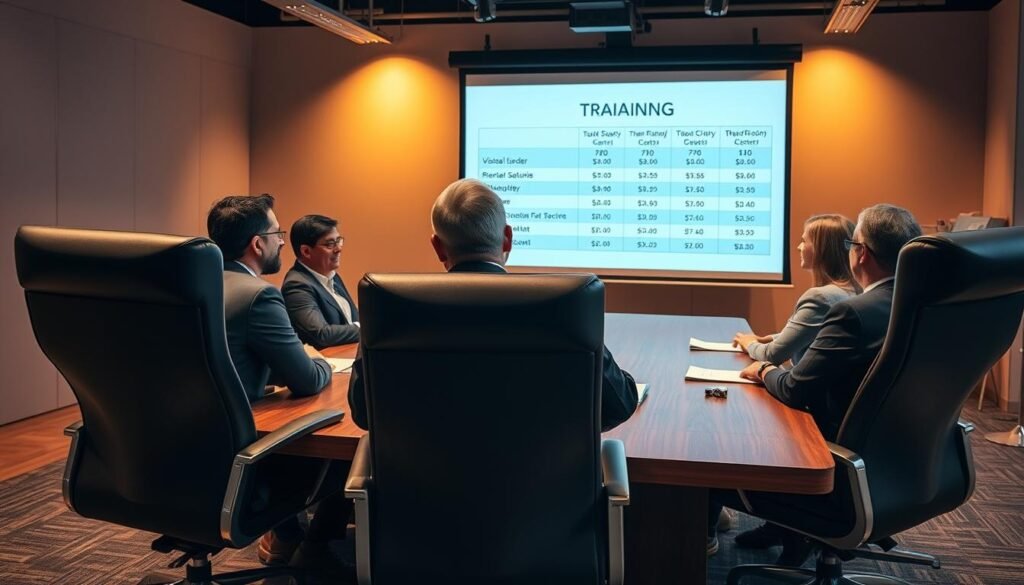Those aiming for the role of a Vistage Chair often ponder the financial commitment needed. This role is highly esteemed.
The path to becoming a Vistage Chair comes with various costs. These include application fees, training expenses, and ongoing membership dues. These costs can be quite high.
It’s vital to grasp the total cost of becoming a Vistage Chair. This knowledge helps in making a well-informed choice.
Key Takeaways
- The cost of becoming a Vistage Chair includes multiple expenses.
- Application fees, training costs, and membership fees are part of the overall cost.
- Understanding these costs is essential for aspiring Vistage Chairs.
- The investment required can be significant.
- Aspiring Vistage Chairs should carefully consider these expenses.
The Vistage Chair Opportunity
Becoming a Vistage Chair is a prestigious opportunity that offers a unique blend of leadership, guidance, and community impact. Vistage Chairs are experienced professionals who facilitate peer advisory groups. They provide strategic guidance and support to CEOs and business leaders.
What Vistage Chairs Do
Vistage Chairs undergo rigorous training and must have significant executive experience. Their role involves facilitating discussions, providing insights, and helping members navigate complex business challenges. Effective Vistage Chairs bring a wealth of knowledge and a fresh perspective to the table, driving growth and innovation within the groups they lead.
The Value Proposition of Being a Chair
The value proposition of being a Vistage Chair lies in the impact they have on business leaders and the communities they serve. By providing a trusted forum for discussion and guidance, Vistage Chairs help CEOs make informed decisions, overcome obstacles, and achieve their goals. This role not only contributes to the success of individual businesses but also fosters a broader culture of leadership and collaboration.
Impact on Business Leaders and Communities
Vistage Chairs have a profound impact on both business leaders and the wider community. They facilitate the exchange of ideas, best practices, and experiences among CEOs, promoting a culture of excellence and innovation. As noted by a Vistage Chair, “The role is not just about facilitating groups; it’s about making a tangible difference in the lives of business leaders and their organizations.”
“The role of a Vistage Chair is to empower CEOs with the insights and confidence needed to drive their businesses forward.”
The benefits of being a Vistage Chair extend beyond personal and professional growth, contributing to the overall health and prosperity of the business community.
Qualifications and Prerequisites
The role of a Vistage Chair is demanding, requiring expertise, leadership, and a solid business network. To qualify, individuals must meet certain criteria. These enable them to lead and support Vistage members effectively.
Professional Experience Requirements
Those interested in becoming Vistage Chairs must have extensive executive experience. This experience, often from senior leadership roles, is essential. It allows them to understand and address the challenges faced by Vistage members. Typically, candidates have held CEO, CFO, or other C-suite positions, giving them a deep understanding of business operations and leadership.
Leadership and Coaching Abilities
Strong leadership and coaching skills are critical for a Vistage Chair. They must lead group discussions, offer one-on-one coaching, and create an environment where members feel supported and challenged. Effective Vistage Chairs have excellent communication skills, empathy, and the ability to build trust with their members.
Business Acumen and Network
A strong business network and keen business acumen are essential for a Vistage Chair. They must understand various industries and be well-connected to provide members with valuable resources and expertise. This network also aids in identifying and introducing new members to the group.
Industry Expertise Considerations
While not mandatory, industry-specific expertise can be beneficial. It enables them to offer more tailored guidance and understand the unique challenges faced by members. Adaptability and the ability to learn are also key, as Vistage groups are diverse in terms of industry.
As noted by a seasoned Vistage Chair,
“The key to success lies in the ability to connect with members on a personal and professional level, understanding their unique challenges, and providing actionable advice that drives results.”

In conclusion, becoming a Vistage Chair requires a mix of professional experience, leadership, and a strong business network. Understanding these qualifications is the first step towards pursuing this rewarding career path.
The Application and Selection Process
To become a Vistage Chair, one must navigate a multi-step application and selection process. This process aims to identify and select highly qualified professionals. They must be able to lead Vistage groups effectively.
Initial Application Steps
The journey starts with an initial application. It requires detailed information about the candidate’s professional background, leadership experience, and coaching abilities. Candidates must demonstrate a strong track record of leadership and a deep understanding of the Vistage chair role.
Interview and Assessment Phases
After the initial application, candidates move to interview and assessment phases. These phases are critical in evaluating a candidate’s leadership style, business acumen, and ability to connect with CEOs. The assessment may include psychological evaluations and interviews with existing Vistage Chairs.
Final Selection Criteria
The final selection is based on a thorough evaluation of the candidate’s fit for the Vistage Chair role. This includes their ability to facilitate group discussions, provide strategic guidance, and foster a supportive community among members.
Timeline Expectations
The entire process, from initial application to final selection, can take several months. Candidates are expected to be patient and prepared for a thorough evaluation. The timeline may vary based on the candidate’s background and the specific requirements of the Vistage group they are applying to.
How Much Does It Cost to Become a Vistage Chair?
Becoming a Vistage Chair comes with several costs. These include initial application fees, training and certification expenses, and ongoing membership fees. It’s important to understand these costs before starting the process.
Initial Application and Assessment Fees
The first step is submitting an application, which incurs a fee. This fee covers the assessment process. It evaluates candidates for their suitability for the role. The cost can vary, so it’s vital to include it in your budget.
Training and Certification Costs
After selection, aspiring Vistage Chairs undergo training and certification. These programs are essential for developing the necessary skills and knowledge. The cost is significant but a necessary investment in your professional growth.

Ongoing Membership Fees
As a Vistage Chair, you’ll need to pay ongoing membership fees. These fees support your continued involvement with Vistage. They provide access to resources, networking opportunities, and ongoing training. The cost varies based on your level of involvement and the programs you participate in.
Financing Options and Payment Plans
Vistage offers various financing options and payment plans to help manage costs. These are designed to make the investment more accessible. Exploring these options can help find the best fit for your financial situation.
In conclusion, becoming a Vistage Chair requires a significant financial investment. Understanding the costs, including initial fees, training, and ongoing membership, is essential. By exploring financing options and payment plans, you can make the investment more manageable.
Training and Certification Expenses
Embarking on the journey to become a Vistage Chair comes with significant training and certification costs. Vistage offers extensive training, ensuring Chairs are well-prepared to lead effectively. This investment is essential for those aiming to excel in this role.
Core Training Program Breakdown
The core training program for Vistage Chairs lays the groundwork for understanding the role’s responsibilities. It covers:
- Leadership development
- Coaching techniques
- Group dynamics
- Business acumen
The cost for this foundational training is a significant investment, typically ranging from $2,000 to $5,000. This varies based on location and training format.

Advanced Certification Requirements
Vistage also offers advanced certification programs to further enhance Chairs’ skills. These programs tackle complex leadership challenges and are priced between $1,000 to $3,000.
Continuing Education Investments
For Vistage Chairs, ongoing education is critical to stay current with leadership strategies and industry trends. The costs for these educational opportunities can range from $500 to $2,000, depending on the workshop or seminar.
Required vs. Optional Training
It’s important to distinguish between required and optional training. Required training, which includes the core program, is essential for certification. Optional training, on the other hand, offers additional skills and knowledge.
| Training Type | Cost Range | Description |
|---|---|---|
| Core Training | $2,000 – $5,000 | Foundational training for Vistage Chairs |
| Advanced Certification | $1,000 – $3,000 | Enhanced skills and knowledge for complex leadership |
| Continuing Education | $500 – $2,000 | Workshops and seminars for ongoing development |
Prospective Vistage Chairs must understand the costs of training and certification. By investing in thorough training, they can develop the skills needed to excel in their roles.
Business Setup and Operational Costs
Starting a Vistage Chair practice requires understanding various costs for setup and operation. These expenses are essential for a successful and lasting business.
Legal Structure Considerations
Choosing the right legal structure is a critical first step. Options include sole proprietorship, partnership, LLC, or corporation. Each has implications for liability, taxes, and complexity. It’s vital to consult a legal expert to pick the best structure for your goals and personal situation.
Marketing and Member Acquisition Expenses
Marketing is key to attracting clients and growing your practice. Costs include digital marketing, networking, and promotional materials. A solid marketing plan is essential for attracting and keeping members.
| Marketing Strategy | Estimated Cost | Potential ROI |
|---|---|---|
| Digital Marketing | $1,000 – $5,000 | 200% – 500% |
| Networking Events | $500 – $2,000 | 150% – 300% |
| Promotional Materials | $200 – $1,000 | 100% – 200% |
Administrative and Technology Investments
Administrative costs cover office expenses, software, and support staff. Technology investments are for CRM systems, meeting tools, and security. These are vital for efficient operation and quality service.
Office and Meeting Space Requirements
You might need to rent office or meeting space. Costs depend on location, size, and amenities. A professional environment is important for productive meetings and client interactions.

Understanding and budgeting for these costs are essential for a successful Vistage Chair practice. Proper planning and management of these expenses can lead to a sustainable and profitable business.
Revenue and ROI Analysis
The revenue for Vistage Chairs is considerable, making it a lucrative opportunity for those who invest. As a Vistage Chair, your earnings are directly linked to the success of your chair practice. This makes it a performance-based venture.
Typical Earnings Structure
Vistage Chairs earn through membership fees, coaching services, and other business activities. The structure rewards Chairs who build a strong client base and deliver quality services.
Earnings can be substantial for experienced Chairs. Earnings depend on the size and engagement of your membership, the quality of your coaching, and your marketing prowess.
Building a Profitable Chair Practice
To be profitable, Vistage Chairs must focus on building a robust practice. This involves a solid marketing strategy, exceptional coaching, and high client satisfaction.
- Develop a niche expertise to stand out
- Use Vistage’s network and resources to support your practice
- Continuously enhance your coaching skills and knowledge
Timeline to Profitability
The time to achieve profitability varies. It depends on your experience, marketing success, and service demand. Generally, it takes several months to a few years to build a profitable practice.
Key Factors: A strong network, quality services, and client needs adaptation are critical for quick profitability.
Comparing Investment to Returns
Assessing the investment in becoming a Vistage Chair against the returns is vital. While there are significant upfront costs, including vistage chair membership costs and vistage chair training investment, successful Chairs can earn more than these costs.
Understanding the revenue and ROI of being a Vistage Chair aids in making informed investment decisions. With strategic planning, dedication, and a focus on quality services, the financial gains can be significant.
Hidden Costs and Practical Considerations
The cost of becoming a Vistage Chair is not just about the direct fees. There are hidden costs and practical considerations that need to be considered. These factors are important for making an informed decision.
Travel and Networking Expenses
As a Vistage Chair, attending conferences, meetings, and networking events is a must. Travel expenses such as flights, accommodations, and meals can quickly add up. Budgeting for these costs is essential to maintain a professional image.
Time Investment vs. Monetary Investment
The time commitment for a Vistage Chair is significant. Coaching and mentoring members, preparing for meetings, and other activities require a lot of time. It’s important to consider this time investment against the monetary gains.
Insurance and Liability Considerations
Vistage Chairs may need to consider liability insurance to protect themselves. This is due to the risks associated with their role. Understanding the legal and financial implications is key.
Work-Life Balance Implications
Keeping a healthy work-life balance is critical for a Vistage Chair. The role’s demands can be high. Effective time management is necessary to avoid burnout.
| Category | Estimated Cost | Frequency |
|---|---|---|
| Travel Expenses | $1,000 – $3,000 | Quarterly |
| Liability Insurance | $500 – $1,500 | Annually |
| Training and Development | $2,000 – $5,000 | Annually |
Understanding the hidden costs and practical considerations is essential for those considering becoming a Vistage Chair. Being aware of these factors helps prepare for the challenges and opportunities this role offers.
Conclusion
To become a Vistage Chair, one must navigate a complex landscape of costs, qualifications, and practical considerations. The journey involves significant financial investments. This includes initial application fees, training and certification costs, and ongoing membership fees. The role also demands substantial professional experience, leadership abilities, and a strong network.
Key Considerations include not only the direct costs but also the time investment, travel expenses, and the need to maintain a work-life balance. The return on investment is significant, with a well-structured chair practice potentially generating substantial revenue.
Ultimately, becoming a Vistage Chair requires a deep understanding of these factors and a strategic approach to managing them. By carefully evaluating the costs, qualifications, and practical considerations, individuals can make informed decisions about pursuing this rewarding career path.
Sources
For further information on becoming a Vistage Chair, the following sources provide valuable insights.
- Vistage Official Website
- Vistage Chair Resources
- Vistage Chair Community on LinkedIn
- Detailed Analysis of Vistage Chair Costs
These sources offer a detailed understanding of the role, responsibilities, and costs associated with being a Vistage Chair.
FAQ
What are the initial costs associated with becoming a Vistage Chair?
Initial costs include application and assessment fees, which vary, and training costs. It’s vital to check the Vistage website or talk to a Vistage representative for the latest fees.
How much does Vistage Chair training cost?
Training costs are part of the overall investment. It covers the core program and any advanced certifications. For exact pricing, contact Vistage directly.
Are there ongoing expenses after becoming a Vistage Chair?
Yes, there are ongoing fees, education costs, and expenses for running a chair practice. This includes marketing, admin, and meeting space rentals.
What financing options are available for becoming a Vistage Chair?
Vistage might offer financing or payment plans to manage costs. For details, reach out to Vistage about available options.
How do I determine if the cost of becoming a Vistage Chair is a good investment?
Evaluate the investment by considering revenue, training value, and personal and business impact. Compare initial costs to expected returns to gauge viability.
What are the typical earnings for a Vistage Chair?
Earnings vary based on practice size, member count, and experience. Review Vistage’s earnings structure and speak with chairs for insights.
How long does it take to become profitable as a Vistage Chair?
Profitability timeframes vary based on practice building, marketing, and member strategies. Understanding typical timelines and success strategies is key for planning.
Are there any hidden costs associated with being a Vistage Chair?
Yes, hidden costs include travel, time, insurance, and liability. Being aware of these helps in planning and budgeting for success.
What kind of support does Vistage offer to new Chairs?
Vistage offers training, ongoing support, and resources for new chairs. This includes initial training, education, and a network of experienced chairs.
How does being a Vistage Chair impact work-life balance?
The role demands significant time, affecting work-life balance. Understanding the role’s demands and planning can help manage its impact on personal and professional life.
